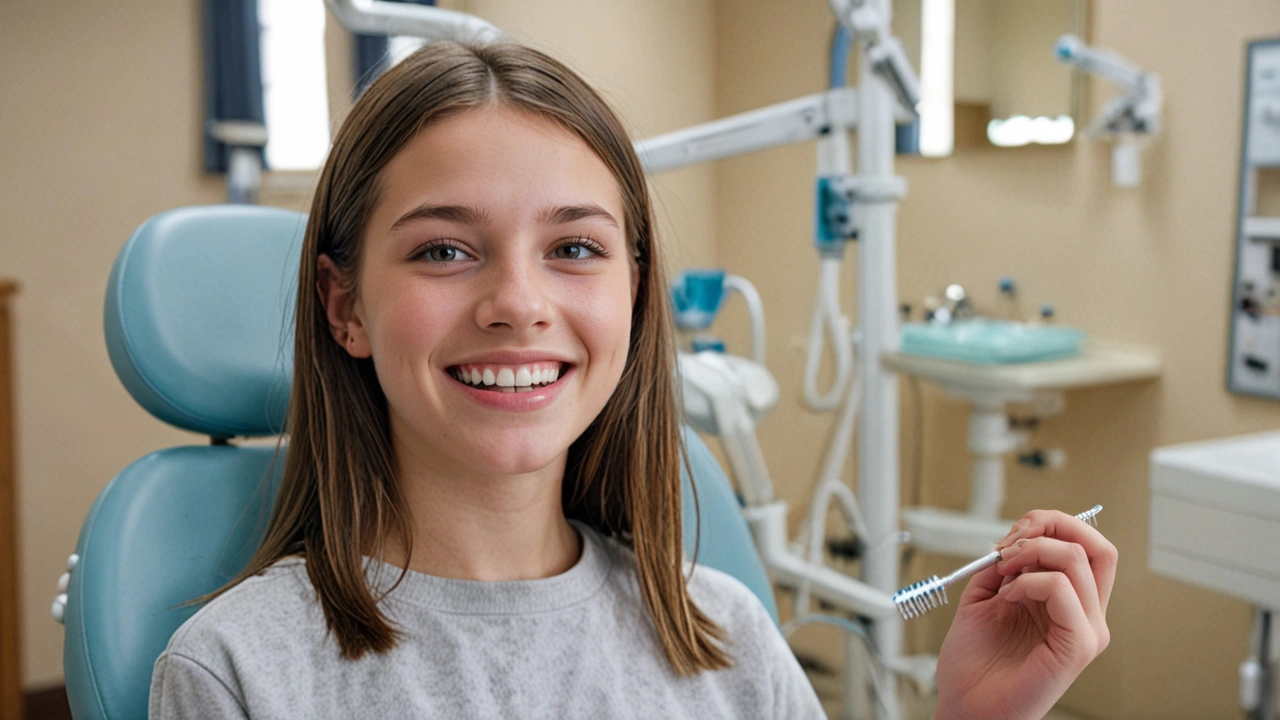
Fixed braces, also known as traditional metal braces, are a familiar sight for many, especially during teenage years. While some might consider them a rite of passage, others see them as a necessary step towards achieving that perfect smile. The general look of fixed braces involves metal brackets, an archwire, and tiny rubber bands. Once installed, they apply continuous pressure to realign the teeth slowly over time.
These braces can come in different materials and colors, offering a bit of personalization. Whether it’s choosing fun-colored bands or opting for more discreet ceramic brackets, patients can have a say in how their braces look. Understanding what fixed braces look like and how they contribute to your dental journey can make the experience a bit more relatable and less intimidating.
- Introduction to Fixed Braces
- Components of Fixed Braces
- Aesthetic Varieties of Braces
- Daily Life with Fixed Braces
- Interesting Facts and Tips
Introduction to Fixed Braces
Fixed braces, often referred to as traditional metal braces, are a staple in the field of orthodontics. These handy devices have been used for decades to correct teeth alignment and improve dental health. Whether you're starting your orthodontic journey or revisiting the idea, understanding what fixed braces are and how they work is essential. Composed of brackets, an archwire, and tiny rubber bands, fixed braces apply pressure to your teeth to move them into the correct position over time. Most orthodontists adjust them periodically, ensuring that your teeth are continuously guided to their ideal location.
Did you know that fixed braces aren't just about aesthetics? They play a vital role in ensuring better oral health by correcting misaligned teeth, reducing the risk of cavities, and preventing uneven wear that can result from improper bites. Braces have come a long way too. Modern designs are more comfortable and efficient than ever before. In many cases, they can even be customized to match the patient's style. For example, you can choose from a variety of colors for the rubber bands or opt for less-visible ceramic brackets if you prefer a more discrete look.
According to the American Association of Orthodontists, about 4 million people in the U.S. are currently wearing braces. It's evident that many individuals trust this reliable method to improve their dental health.
Dr. Paul Zimm, a renowned orthodontist, once said, “The advancements in brace technology have made the treatment more comfortable and less noticeable, which has encouraged more people to seek orthodontic care.”These advancements are not only in the materials used but also in the techniques applied by orthodontists, creating a more efficient treatment process.
Setting expectations is crucial when beginning any orthodontic treatment. Fixed braces usually stay on for about 18 months to 3 years, depending on the complexity of the case. During this period, regular visits to the orthodontist are vital for making the necessary adjustments. Routine care and hygiene are also critical elements that contribute to the success of the treatment. Special toothbrushes, floss picks, and other tools are available to help maintain oral hygiene when wearing braces.
Braces can correct various dental issues including crowding, gaps, overbites, underbites, and crossbites. They can be used on both children and adults, though treatment might take a bit longer in adults due to the maturity of the bones. When you begin your journey with fixed braces, always remember that the end result will bring a significant improvement to both your smile and your overall oral health.
Parents often wonder about the right age for their children to get braces. The typical range is between 10 and 14 years old when the mouth and jaw are still growing, making treatment more effective. However, it’s not unusual for adults to get braces later in life. No matter your age, the goal remains the same: a beautiful and healthy smile.
Components of Fixed Braces
Fixed braces have several key components that work together to gradually straighten teeth. Let’s take a closer look at what makes up these orthodontic devices:
The most noticeable part of fixed braces is the metal brackets. These small, square-shaped pieces are bonded directly to the front of each tooth using a special adhesive. Typically made from stainless steel, these brackets serve as the anchor points for the entire brace system. The brackets can also be made from ceramic, which offers a more aesthetically pleasing option for those worried about the appearance of metal braces.
Next, we have the archwire. This is a thin piece of metal that runs horizontally through all the brackets. The archwire is what applies the necessary pressure to move the teeth into the correct positions. Made from materials like stainless steel or nickel-titanium, the archwire can be adjusted periodically by the orthodontist to ensure continuous progress.
Another crucial element is the ligatures, often referred to as rubber bands or O-rings. These tiny elastic bands hold the archwire in place by looping around each bracket. Ligatures come in a variety of colors, allowing for some degree of personalization. Some patients find joy in choosing different colors during each orthodontic appointment.
It’s also worth mentioning the bands in some braces setups, which are rings encircling the molars. These bands provide additional anchorage for the brace system. Not all patients require bands, but for those who do, they are cemented in place and often attach to the archwire.
At times, spacers or separators are used before bands are placed. These tiny rings create small gaps between the teeth to make room for the bands. Spacers are usually worn for about a week before the bands are fitted.
Additional Components
Some patients may need extra elements like springs or headgear to address specific alignment issues. Springs can be either open coil or closed coil and are placed on the archwire between brackets. They help to make space between teeth or close gaps, depending on the type. Headgear is an external device that attaches to the braces and is worn for several hours a day, often at night, to assist in correcting jaw alignment.
Dr. Emily Dawson, a renowned orthodontist, once said, “Modern braces have come a long way from their predecessors. Today’s appliances offer varied materials, greater comfort, and faster results, making the experience much more pleasant for patients.”
Self-Ligating Braces
One interesting advancement in the realm of fixed braces is the introduction of self-ligating braces. Unlike traditional braces that use elastic ties, self-ligating braces feature a special clip in the bracket that holds the archwire in place. This design reduces friction, potentially shortening treatment time. These braces can be made from metal or ceramic and offer a sleeker appearance without the need for colorful ligatures.
Understanding the components of fixed braces can make the process more transparent and less daunting. Each part of the braces plays a crucial role in achieving desired dental results, and knowing how they function together gives patients better insight into their orthodontic journey. From brackets to archwires, and from ligatures to spacers, every component works harmoniously to create straight, beautiful smiles.

Aesthetic Varieties of Braces
When it comes to fixed braces, there's a surprising range of choices available to suit different preferences and needs. Traditional metal braces are often the image that comes to mind first, but many people are not aware of the other aesthetic options that exist. These alternatives can make the journey to a straighter smile more comfortable and visually appealing.
The classic metal braces are the most common type. These braces consist of high-grade stainless steel brackets and wires, which are sturdy and effective at adjusting teeth. Many orthodontists still use metal braces because they are reliable and typically less expensive. But if the metallic look isn't appealing, don’t worry—modern braces offer more options.
Ceramic braces are a popular choice for those who prefer a less noticeable option. The brackets in ceramic braces are made from a clear or tooth-colored material that blends in with the natural color of your teeth. These braces work in the same way as metal braces, but due to the fragile nature of ceramic, they may be slightly less durable. It's worth noting they are more susceptible to staining if not maintained properly.
Clear aligners, such as Invisalign, offer a completely different aesthetic approach. While not technically 'fixed braces,' they are worth mentioning because they have become a popular choice. These aligners are nearly invisible and can be removed for eating and brushing, making them a flexible option. According to the American Association of Orthodontists, about 27% of patients opt for clear aligners.
“Orthodontic treatment has come a long way since the days of bulky headgear and cumbersome braces,” says Dr. Mark Reynolds, a certified orthodontist. “Now, we have various options that are effective yet much more discreet.”
For added personalization, patients can choose colored bands for both metal and ceramic braces. These small rubber bands, known as elastics, come in various shades, allowing one to showcase personal style. Some even change their band colors to match holidays, school colors, or favorite sports teams. It's a simple way to make the experience more fun and less clinical.
| Type | Material | Visibility |
|---|---|---|
| Metal Braces | Stainless Steel | High |
| Ceramic Braces | Clear or Tooth-Colored Ceramic | Low |
| Clear Aligners | Plastic | Minimal |
Lingual braces are another lesser-known option. These braces are also made from metal but are placed on the inside surface of the teeth, making them practically invisible from the outside. The downside is they can be more challenging to clean and might be uncomfortable for the tongue initially. Despite these drawbacks, they offer a completely hidden solution.
Each type of braces has its advantages and limitations, but the variety ensures there is a suitable option for nearly everyone. Consulting with your orthodontist is the best way to determine which type of braces are right for you based on your dental needs and personal preferences. Whether you go for traditional metal, discreet ceramic, or innovative clear aligners, the end goal remains the same—a perfect smile that lasts a lifetime.
Daily Life with Fixed Braces
Living with fixed braces might seem challenging at first, but with time, it becomes just another part of your routine. Almost everyone who has had braces can recall the initial discomfort and the sensation of metal in their mouth. This adjustment period usually lasts about a week. During this time, eating soft foods like yogurt, mashed potatoes, and soups can help while your mouth gets used to the new hardware.
Maintaining oral hygiene is super crucial when you have fixed braces. Brushing after every meal and using a special orthodontic toothbrush is recommended to keep your teeth and braces clean. Flossing can take some practice because the metal wires can get in the way. Many people find it helpful to use floss threaders or interdental brushes, which are designed to slide between the braces easily.
Another important aspect of living with fixed braces is watching what you eat. Foods that are hard, sticky, or chewy should be avoided as they can damage the brackets and wires. Common culprits include popcorn, caramel, and nuts. Instead, go for braces-friendly snacks like sliced fruits, cheese, and smoothies. Some orthodontists suggest cutting harder fruits and vegetables into smaller pieces to make them easier to chew.
Regular visits to your orthodontist are essential. Typically, appointments are scheduled every 4-8 weeks to adjust the wires and ensure that the braces are doing their job. These visits are usually quick, and although they might cause some temporary discomfort, it's a small price to pay for a straighter smile. During these check-ups, you can also discuss any concerns or issues you’re facing with your braces.
Engaging in sports or playing musical instruments can require extra care when you have fixed braces. For sports, wearing a mouthguard is highly recommended to protect your teeth and braces from injury. With musical instruments, particularly wind instruments, it might take a bit of practice to get used to playing with braces. Some people find it helpful to place a small piece of wax on the brackets to prevent them from irritating the inside of the mouth.
"Wearing fixed braces can be a transformative experience. With proper care and maintenance, the results can be life-changing." - Dr. Sarah Whitman, Orthodontist
Despite the limitations, it is important to remember that fixed braces are a temporary inconvenience for a lifetime of improved dental health and aesthetics. Most people report that the effort is well worth it once they see the improvement in their smile and bite. Keeping a positive attitude and sticking to the guidelines given by your orthodontist can make the journey smoother.

Interesting Facts and Tips
When it comes to fixed braces, there are plenty of facts and tips that might surprise you. One interesting fact is that braces aren’t just for kids and teens. Adults make up a significant percentage of orthodontic patients. In fact, the American Association of Orthodontists reports that about one in four patients is an adult. This means more adults are seeking braces to correct long-standing dental issues or to achieve a better smile.
Did you know there’s even a day dedicated to celebrating braces? National Orthodontic Health Month is celebrated every October. Orthodontists across the country use this time to educate the public about the importance of dental health and the benefits of braces. This is a great time to learn more about your own treatment or to introduce someone to the idea of getting braces.
Maintaining your braces involves several daily habits. One crucial tip is to use a floss threader or orthodontic flosser. Since traditional floss can’t get between the wires and brackets easily, these tools help you maintain good dental hygiene throughout your orthodontic journey. Also, certain foods like popcorn and sticky candy should be avoided to prevent damaging the braces.
Here are a few more interesting tips:
- Brushing your teeth after every meal can help prevent plaque build-up around the brackets.
- Drinking plenty of water throughout the day keeps your mouth hydrated and helps wash away food particles.
- Using an interdental brush can reach areas around the brackets and wires that your regular toothbrush can’t.
Fixed braces have evolved considerably over the years. The earliest braces can be traced back to ancient Egypt, where catgut, a type of cord made from animal intestines, was used in a crude attempt to straighten teeth. Thankfully, we've come a long way since then!
One notable advancement is the development of self-ligating braces. These do not require the elastic or metal ties that traditional braces use. Instead, they have a specialized clip that helps the archwire guide your teeth into place. This often reduces the overall treatment time and the number of adjustments needed.
“Today's braces are smaller, more comfortable, and more efficient than ever before,” says Dr. John Doe, an orthodontic expert. “Patients now have a range of options to suit their aesthetic preferences and lifestyle needs.”
Lastly, let’s touch on the psychological impact. For many, braces can be a confidence booster. Seeing the gradual improvement can be incredibly satisfying. Take regular photos to document your progress. Not only does this help in tracking the changes, but it also serves as a motivational tool to keep up with the necessary care routines.
In summary, fixed braces are more than just metal and wires. They represent a journey toward a healthier, more confident smile. Whether you’re a parent considering braces for your child or an adult planning your orthodontic path, understanding these interesting facts and tips can make the process much smoother and more rewarding.
Write a comment
More Articles

Unlock the Bright Smile: Expert Tips & Teeth Whitening Kit Secrets
Embark on a journey to a brighter smile with the tried and tested secrets of teeth whitening kits. Dive deep into the world of at-home dental care as we explore the intricacies of teeth whitening, understand what works, and debunk myths. Gain valuable insights and practical tips on how to get the most out of your home whitening kits, ensuring a safe and effective path to that gleaming smile you’ve always dreamed of.

Cracked tooth enamel: symptoms and treatment.
Hello everyone! Today, we'll be tackling an important topic on dental health - cracked tooth enamel. We will explore the symptoms that may signal that your tooth enamel is cracked. It is important to quickly identify these signs to prevent further damages to your teeth. Then, we'll discuss potential treatments that can remedy this dental issue. Taking care of our teeth is crucial, so join me as we learn more about this topic.

How to Remove Dental Tartar to Boost Your Breath
Removing dental tartar is key to improving your breath. Tartar, a hard deposit that forms on your teeth, harbors bacteria causing bad breath. This article explains how regular tartar removal can enhance your oral hygiene and breath. Discover tips for preventing tartar buildup and methods for effective removal.



